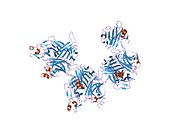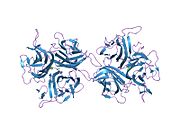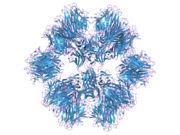B-cell activating factor
Ensembl | |||||||||
|---|---|---|---|---|---|---|---|---|---|
| UniProt | |||||||||
| RefSeq (mRNA) | |||||||||
| RefSeq (protein) | |||||||||
| Location (UCSC) | Chr 13: 108.25 – 108.31 Mb | Chr 8: 10.06 – 10.09 Mb | |||||||
| PubMed search | [3] | [4] | |||||||
| View/Edit Human | View/Edit Mouse |
B-cell activating factor (BAFF) also known as tumor necrosis factor ligand superfamily member 13B and CD257 among other names, is a protein that in humans is encoded by the TNFSF13B gene.[5][6] BAFF is also known as B Lymphocyte Stimulator (BLyS) and TNF- and APOL-related leukocyte expressed ligand (TALL-1) and the Dendritic cell-derived TNF-like molecule (CD257 antigen; cluster of differentiation 257).
Structure and function
BAFF is a
BAFF is a 285-amino acid long peptide
Interactions
B-cell activating factor has been shown to
Interaction between BAFF and BAFF-R activates classical and noncanonical NF-κB signaling pathways. This interaction triggers signals essential for the formation and maintenance of B cell, thus it is important for a B-cell survival.[8]
Recombinant production
Human BLyS has been expressed and purified in E. Coli. The BLyS protein in the engineered bacteria can be as much as 50% to the bacteria's total protein content and still retains activity after a purification procedure.[19]
Clinical significance
As an immunostimulant, BAFF (BLyS, TALL-1) is necessary for maintaining normal immunity. Inadequate level of BAFF will fail to activate B cells to produce enough immunoglobulin and will lead to immunodeficiency.
Excessive level of BAFF causes abnormally high antibody production, results in systemic lupus erythematosus, rheumatoid arthritis, and many other autoimmune diseases.[20] Overexpression of BAFF also correlates with enhanced humoral immunity against malaria infection.[21]
BAFF has been found in renal transplant biopsies with acute
Blisibimod, a fusion protein inhibitor of BAFF, is in development by Anthera Pharmaceuticals, also primarily for the treatment of systemic lupus erythematosus.[25]
BAFF may also be a new mediator of food-related inflammation.[26] Higher levels of BAFF are present in non-atopic compared with atopic patients, and there is not any correlation between BAFF and IgE, suggesting that BAFF might be particularly involved in non-IgE-mediated reactions.[27] In patients with celiac disease, serum BAFF levels are reduced after a gluten-free diet.[28] The same reduction could be present in the recently defined “Non Celiac Gluten sensitivity” (a reaction to gluten which provokes almost the same symptoms of celiac disease and could involve up to 20% of apparently healthy individuals.[29][30]) BAFF is also a specific inducer of insulin resistance and can be a strong link between inflammation and diabetes or obesity.[31][32] BAFF gives the organism a sort of danger signal and usually, according to the evolutionary theories, every human being responds to danger activating thrifty genes in order to store fat and to avoid starvation. BAFF shares many activities with PAF (Platelet Activating Factor) and they are both markers of non-IgE-mediated reactions in food-reactivity.[27]
References
- ^ a b c GRCh38: Ensembl release 89: ENSG00000102524 - Ensembl, May 2017
- ^ a b c GRCm38: Ensembl release 89: ENSMUSG00000031497 - Ensembl, May 2017
- ^ "Human PubMed Reference:". National Center for Biotechnology Information, U.S. National Library of Medicine.
- ^ "Mouse PubMed Reference:". National Center for Biotechnology Information, U.S. National Library of Medicine.
- S2CID 1498303.
- ^ PMID 10359578.
- ^ "Entrez Gene: tumor necrosis factor (ligand) superfamily".
- ^ PMID 22124120.
- S2CID 29060390.
- S2CID 24498929.
- PMID 18295728.
- S2CID 22957179.
- PMID 10880535.
- PMID 12370363.
- S2CID 42673198.
- S2CID 13925100.
- S2CID 4373708.
- PMID 10908663.
- PMID 14673506.
- PMID 28445677.
- PMID 28445672.
- S2CID 28952240.
- PMID 23842189.
- PMID 20135240.
- ^ ClinicalTrials.gov. "PEARL-SC Trial: A Study of the Efficacy, Safety, and Tolerability of A 623 Administration in Subjects With Systemic Lupus Erythematosus". United States National Institute of Health. Retrieved 2011-07-15.
- PMID 21128997.
- ^ PMID 3723786.
- S2CID 44676344.
- PMID 22313950.
- S2CID 206896710.
- PMID 19293640.
- PMID 21701571.
Further reading
- Nardelli B, Moore PA, Li Y, Hilbert DM (July 2002). "B lymphocyte stimulator (BLyS): a therapeutic trichotomy for the treatment of B lymphocyte diseases". Leukemia & Lymphoma. 43 (7): 1367–73. S2CID 2521553.
- Zhou T, Zhang J, Carter R, Kimberly R (2003). "BLyS and B cell autoimmunity". B Cell Biology in Autoimmunity. Vol. 6. pp. 21–37. )
- Stohl W (2005). "A therapeutic role for BLyS antagonists". Lupus. 13 (5): 317–22. S2CID 40631500.
- Quartuccio L, Fabris M, Ferraccioli G (2004). "[B lymphocyte stimulator (BLyS) and monocytes: possible role in autoimmune diseases with a particular reference to rheumatoid arthritis]". Reumatismo. 56 (3): 143–6. PMID 15470519.
- Sutherland AP, Mackay F, Mackay CR (December 2006). "Targeting BAFF: immunomodulation for autoimmune diseases and lymphomas". Pharmacology & Therapeutics. 112 (3): 774–86. PMID 16863659.
- Bossen C, Schneider P (October 2006). "BAFF, APRIL and their receptors: structure, function and signaling" (PDF). Seminars in Immunology. 18 (5): 263–75. PMID 16914324.
- Brink R (October 2006). "Regulation of B cell self-tolerance by BAFF". Seminars in Immunology. 18 (5): 276–83. PMID 16916609.
- Tangye SG, Bryant VL, Cuss AK, Good KL (October 2006). "BAFF, APRIL and human B cell disorders". Seminars in Immunology. 18 (5): 305–17. PMID 16916610.
- Treml LS, Crowley JE, Cancro MP (October 2006). "BLyS receptor signatures resolve homeostatically independent compartments among naïve and antigen-experienced B cells". Seminars in Immunology. 18 (5): 297–304. PMID 16919470.
- Woodland RT, Schmidt MR, Thompson CB (October 2006). "BLyS and B cell homeostasis". Seminars in Immunology. 18 (5): 318–26. PMID 16931037.
- Kalled SL (October 2006). "Impact of the BAFF/BR3 axis on B cell survival, germinal center maintenance and antibody production". Seminars in Immunology. 18 (5): 290–6. PMID 16931038.
- Mackay F, Leung H (October 2006). "The role of the BAFF/APRIL system on T cell function". Seminars in Immunology. 18 (5): 284–9. PMID 16931039.
- Bosello S, Pers JO, Rochas C, Devauchelle V, De Santis M, Daridon C, Saraux A, Ferraccioli GF, Youinou P (2007). "BAFF and rheumatic autoimmune disorders: implications for disease management and therapy". International Journal of Immunopathology and Pharmacology. 20 (1): 1–8. S2CID 46295467.
- Mukhopadhyay A, Ni J, Zhai Y, Yu GL, Aggarwal BB (June 1999). "Identification and characterization of a novel cytokine, THANK, a TNF homologue that activates apoptosis, nuclear factor-kappaB, and c-Jun NH2-terminal kinase". The Journal of Biological Chemistry. 274 (23): 15978–81. PMID 10347144.
- Moore PA, Belvedere O, Orr A, Pieri K, LaFleur DW, Feng P, Soppet D, Charters M, Gentz R, Parmelee D, Li Y, Galperina O, Giri J, Roschke V, Nardelli B, Carrell J, Sosnovtseva S, Greenfield W, Ruben SM, Olsen HS, Fikes J, Hilbert DM (July 1999). "BLyS: member of the tumor necrosis factor family and B lymphocyte stimulator". Science. 285 (5425): 260–3. PMID 10398604.
- Tribouley C, Wallroth M, Chan V, Paliard X, Fang E, Lamson G, Pot D, Escobedo J, Williams LT (December 1999). "Characterization of a new member of the TNF family expressed on antigen presenting cells". Biological Chemistry. 380 (12): 1443–7. S2CID 26187605.
- Gross JA, Johnston J, Mudri S, Enselman R, Dillon SR, Madden K, Xu W, Parrish-Novak J, Foster D, Lofton-Day C, Moore M, Littau A, Grossman A, Haugen H, Foley K, Blumberg H, Harrison K, Kindsvogel W, Clegg CH (April 2000). "TACI and BCMA are receptors for a TNF homologue implicated in B-cell autoimmune disease". Nature. 404 (6781): 995–9. S2CID 4323357.
- Shu HB, Johnson H (August 2000). "B cell maturation protein is a receptor for the tumor necrosis factor family member TALL-1". Proceedings of the National Academy of Sciences of the United States of America. 97 (16): 9156–61. PMID 10908663.
External links
- B-Cell+Activating+Factor at the U.S. National Library of Medicine Medical Subject Headings (MeSH)
- Human DTL genome location and DTL gene details page in the UCSC Genome Browser.
- Human TNFSF13B genome location and TNFSF13B gene details page in the UCSC Genome Browser.







